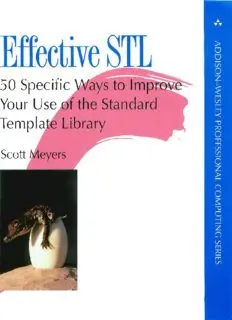Table Of ContentEffective STL
50 Specific Ways to ImproveYour Use of the
StandardTemplate Library
Scott Meyers
...
TT
ADDISON-WESLEY
Boston • SanFrancisco • NewYork • Toronto • Montreal
London • Munich • Paris • Madrid
Capetown • Sydney • Tokyo • Singapore • Mexico City
Manyofthedesignations used by manufacturersand sellers to distinguish theirproductsareclaimedas
trademarks.Wherethosedesignations appear in this book,and we wereawareofa trademarkclaim,the
designations havebeen printed in initial capital lettersor in all capitals.
Theauthorandpublisher have taken care in thepreparation ofthis book,but make no expressed or
implied warrantyofany kind and assume no responsibilityforerrors oromissions. No liabilityis
assumed for incidentalorconsequential damages inconnection withorarising outofthe useofthe
informationorprogramscontainedherein.
Theexcerptfrom Howthe CrinchStole Christmas! byDr.Suess is trademarkedand copyright©Dr.
SuessEnterprises,L.P., 1957(renewed 1985).Used by permission ofRandom HouseChildren'sBooks,
adivision ofRandom House,Inc.
The publisheroffersdiscounts on this book when ordered in quantityfor special sales.Formore
information,pleasecontact:
Pearson Education CorporateSalesDivision
20I W. 103rdStreet
Indianapolis,IN 46290
(800)428-5331
corpsales@pearsoned.com
VisitAWon theWeb: www.awl.com/cseng/
LibraryofCongress Cataloging-in-Publicatiol/ Data
Meyer,Scott(ScottDouglas)
EffectiveSTL: 50specificways to improve your useofthestandard template libraryl
ScottMeyers.
p.cm.- (Addison-Wesley professional computingseries)
Includes bibliographical references and index.
ISBN:0-201-74962-9
I.C++(Computer programlanguage) 2.Standard template library. 1.Title.II.Series.
QA76.73.CI53.M49 2001
005.13'3-dc21
2001022851
CIP
Copyright© 2001 byAddison-Wesley
All rights reserved. No partofthis publication may be reproduced,stored in aretrieval system,or
transmitted,inany form,orby any means,electronic,mechanical,photocopying,recording,orother
wise,withoutthe priorconsentofthe publisher.Printed in the United StatesofAmerica. Published
simultaneously in Canada.
ISBN0-201-74962-9
Textprintedon recycled paper
23456789 IO-CRW-0504030201
Secondprinting. July 200I
For Woofieland.
Contents
Preface xi
Acknowledgments xv
Introduction 1
Chapter 1: Containers 11
Item 1: Choose your containers with care. 11
Item 2: Beware the illusion ofcontainer-independent code. 15
Item 3: Make copying cheap and correct for objects
in containers. 20
Item 4: Call empty instead ofchecking sizeO against zero. 23
Item 5: Preferrange member functions to theirsingle-element
counterparts. 24
Item 6: Be alert for C++'s most vexing parse. 33
Item 7: When using containers ofnewed pointers, remember to
delete the pointers before the container is destroyed. 36
Item 8: Never create containers ofauto_ptrs. 40
Item 9: Choose carefully among erasing options. 43
Item 10: Be aware ofallocator conventions and restrictions. 48
Item 11: Understand the legitimate uses ofcustom allocators. 54
Item 12: Have realistic expectations about the thread safety
ofSTL containers. 58
Chapter 2: vector and string 63
Item 13: Prefervector and string to dynamically allocated arrays. 63
Item 14: Use reserve to avoid unnecessary reallocations. 66
Item 15: Be aware ofvariations in string implementations. 68
viii Contents Effective STL
Item 16: Knowhow to pass vector and string data to legacyAPIs. 74
Item 17: Use "the swap trick" to trim excess capacity. 77
Item 18: Avoid using vector<bool>. 79
Chapter 3: Associative Containers 83
Item 19: Understand the difference between equality and
equivalence. 83
Item 20: SpecifY comparison types for associative containers
ofpointers. 88
Item 21: Always have comparison functions return false for
equal values. 92
Item 22: Avoid in-place key modification in set and multiset. 95
Item 23: Consider replacing associative containers with
sorted vectors. 100
Item 24: Choose carefully between map::operator[] and
map::insert when efficiency is important. 106
Item 25: Familiarizeyourselfwith the nonstandard hashed
containers. III
Chapter 4: Iterators 116
Item 26: Prefer iterator to consCiterator, reverse_iterator, and
const_reverse_iterator. 116
Item 27: Use distance and advance to convert a container's
const_iterators to iterators. 120
Item 28: Understand howto use a reverse_iterator's base iterator. 123
Item 29: Consider istreambuUterators for character-by-character
input. 126
Chapter 5: Algorithms 128
Item 30: Make sure destination ranges are big enough. 129
Item 31: Know your sorting options. 133
Item 32: Follow remove-like algorithms by erase ifyou really
want to remove something. 139
Item 33: Be wary ofremove-like algorithms on containers of
pointers. 143
Item 34: Note which algorithms expect sorted ranges. 146
Item 35: Implement simple case-insensitive string
comparisons via mismatch or lexicographical_compare. 150
Item 36: Understand the proper implementation ofcopy_if. 154
Effective STL Contents ix
Item 37: Use accumulate or for_each to summarize ranges. 156
Chapter 6: Functors, Functor Classes,
Functions, etc. 162
Item 38: Design functor classes for pass-by-value. 162
Item 39: Make predicates pure functions. 166
Item 40: Make functor classes adaptable. 169
Item 41: Understand the reasons for ptr_fun, mem_fun, and
mem_fun_ref. 173
Item 42: Make sure less<T> means operator<. 177
Chapter 7: Programming with the STL 181
Item 43: Prefer algorithm calls to hand-written loops. 181
Item 44: Prefer member functions to algorithms with the
same names. 190
Item 45: DistingUish among count, find, binary_search,
lower_bound, upper_bound, and equal_range. 192
Item 46: Consider function objects instead offunctions as
algorithm parameters. 201
Item 47: Avoid producing write-only code. 206
Item 48: Always #include the proper headers. 209
Item 49: Learn to decipher STL-related compiler diagnostics. 210
Item 50: Familiarize yourselfwith STL-related web sites. 217
Bibliography 225
Appendix A: Locales and Case-Insensitive
String Comparisons 229
Appendix B: Remarks on Microsoft's
STL Platforms 239
Index 245

